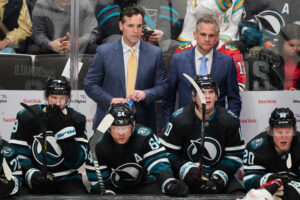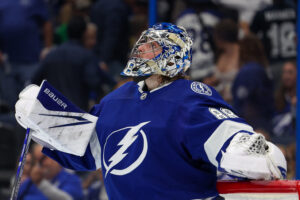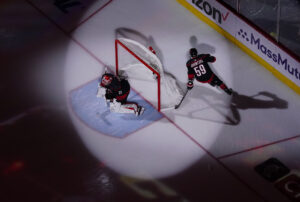In 2011, the Boston Bruins broke a 39-year championship drought. Leading the way down the middle were two young stars. Patrice Bergeron and David Krejci won in the faceoff dot and were significant offensive contributors. The team has since gone on to make two more appearances in the Stanley Cup Finals during their tenure. Almost 10 years have passed since that title. Bergeron is a staple of Boston sports and will likely sign another contract to remain a Bruin. It is not so easy to say the same about David Krejci. While valuable, this is a team that has brought in a lot of youth in recent years. At 34-years-old, don’t be surprised if 46 is replaced by a younger face that has quickly become a fan favourite in Charlie Coyle.
Charlie Coyle Will be Boston’s Next Second Line Centre
Boston hockey runs in Charlie Coyle’s blood. Growing up in Weymouth, Massachusetts, Coyle grew up a fan of the Bruins. After an impressive showing with the US National Team Development Program, he was drafted 28th overall by the San Jose Sharks in 2010. Coyle elected to play at Boston University after being drafted. His freshman year at BU would be the 2010-11 season, when David Krejci helped deliver a Stanley Cup to Boston. While he would never play for San Jose. He was instead traded to the Minnesota Wild, where he would spend eight seasons in the organization. During that time, Coyle’s talents would catch the eye of Boston General Manager Don Sweeney. In a 2019 trade deadline move, Sweeney brought him into the fold. Coyle earned his place in Boston rather quickly, with fans from around the league praising his blow-up. His play was enough to earn him a six-year contract extension in November of 2019, only nine months after joining his hometown team.
Charlie Coyle is Krejci 2.0
Coyle’s production on the ice has been remarkable. He displayed a fire in each game that no one expected. While his first few games started slowly in terms of offensive production, his pace picked up during the postseason. His six points in 21 regular season games with Boston exploded into 16 points in 24 playoff contests. That style of clutch has been seen in David Krejci’s game throughout his career. He has averaged 0.75 points per game during the regular season. That jumps up to 0.79 during the playoffs. While that jump does not seem far, Krejci has always seemed to play harder during the postseason and his points have typically come at critical times.
Charlie Coyle’s regular seasons have been just that- regular. He doesn’t do much to stand out and be a highly productive forward. He does what it takes to get the job done and is fairly average. His playoff performances are what earned him the sizable extension. In six playoff appearances with Minnesota, Coyle tallied 15 points in 44 games for an average of 0.34 points per game. With Boston, Coyle has played in 37 playoff games over two seasons. In that time, he has 21 points. That comes to 0.57 points per game. While those are small sample sizes, it is clear that Coyle has been clutch in a manner eerily similar to Krejci.
Captain Clutch
During this last postseason run, Charlie Coyle scored at critical times. In their first matchup with the Carolina Hurricanes, Coyle scored the goal that gave Boston a 2-1 lead early in the second period, swinging momentum. Coyle also excels at hitting home runs. Or at least we think so based on what he did in game three of that series. Coyle batted a loose puck out of the air to give the Bruins the first goal of the game. He also assisted on Sean Kuraly’s goal that proved to be a game-winner roughly 21 minutes later. Coyle’s net-front stick positioning came into play again in the first game against the Tampa Bay Lightning. He scored the first goal of the series during Boston’s only win against Tampa. Last postseason may not have been as flamboyant as his first with Boston, but he knew how to produce in clutch moments.
The Money
We need to take a second look at the money Coyle is going to make over the next six years. His $5.25 million salary-cap hit is not what you pay a player to be your third-line centre. As the depth chart stands right now, Coyle slots in on the third line as a centre, and can play on Krejci’s wing if he jumps up to the second unit. Some other players that currently make within $250,000 of Coyle include Jeff Carter, Bo Horvat, and Max Domi. None of those players are third-liners. They are all capable of playing second-line minutes and even first-line on some teams. It simply does not fit Boston’s philosophy in terms of how they negotiate contracts. They rarely overspend, if ever. For Coyle to remain in a third-line role while earning that much money would be a travesty.
Krejci’s current contract makes his replacement more likely. He is entering the final season of a contract that paid him $7.25 million per year. He is the highest-paid player on the team. The franchise has done an excellent job of managing team-friendly deals. Krejci’s is the most player-friendly by far. If the team wants to keep Krejci, it will be for a lower cost. They will not sign him to another contract of that value, especially with more valuable players making significantly less. With the current financial situation of the NHL, a flat salary cap makes the future all the more uncertain. If Don Sweeney is smart, he will let Krejci seek a new contract in free agency and promote Coyle to the second-line center. While it may be difficult to part with a player who has been a cornerstone of your organization, they have his replacement in house.
Hockey is a Business
If Sweeney wants to manage his assets properly, the right move would be to move on from Krejci at the end of his contract. As a 34-year-old centre, you have to wonder when Krejci will begin to show signs of decline. Those days could be on the horizon. When you have a capable replacement such as Charlie Coyle, the front office must make the tough decision. Hockey is a business first and foremost. As much as it will sting to see 46 suiting up for a different team two years from now, it makes sense if this team wants to continue their winning ways.
Main Photo:






